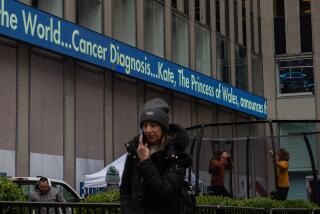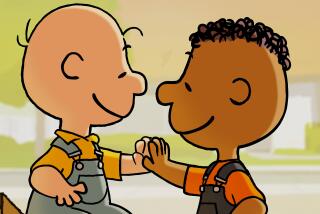Cancer in the Classroom : Schools: Teachers employ the Peanuts gang when a pupil’s plight has classmates asking, ‘Why?’
- Share via
Ten-year-old Bryn Shuman leaned against the blackboard and twisted a lock of the shoulder-length wig she has worn for the past 2 1/2 years.
She shyly lifted the wig to show where her once-blond hair, lost during chemotherapy treatments for cancer, is growing back a light brown color.
Teachers at Stone Creek Elementary School in Irvine say that Bryn’s wig and sporadic absences prompted a lot of questions from classmates: What is cancer? Will I catch it? Is she going to die?
So when Bryn sat down Thursday with about 60 of her fellow fifth-graders to watch a Peanuts cartoon special about a child who has cancer, she knew just what to expect.
“My brothers used to treat me like I was really special--like they would try and help me get down a step or something,” said Bryn, clad in a jean jacket, pink T-shirt and sneakers. “I told them, ‘I’m not going to fall--I still have my legs,’ and I told them to treat me like a normal kid.”
Children at two Orange County elementary schools were asked to evaluate the show “Why, Charlie Brown, Why?,” which aired a week ago on CBS. The evaluations will be forwarded to CBS, Peanuts creator Charles Schulz and the American Cancer Society in an effort to promote the episode’s use to educate children about the disease, which the Cancer Society calls the leading cause of death in American children ages 3 to 14.
“We’re basically working to dispel the myths and misconceptions that are associated with cancer,” said Michele Massey, an Irvine resident who started the educational group Kids Cancer Connection after an illness of her daughter was diagnosed as leukemia.
“They teach them about AIDS, they teach them about sex education. Why not teach them about something that every single one of them will come in contact with at some point in their lives?” Massey said.
The half-hour cartoon follows the illness of Janice, a child with leukemia. Linus and Charlie Brown, her worried friends, confront a number of the aspects of her illness, from the pain of medical tests to the social stigma of going bald.
Janice’s leukemia goes into remission--meaning that her hair grows back and she regains her health--as do 60% of all children with cancer.
After watching the show, Dr. Ernest Katz, a specialist in children’s cancer, asked the class how someone with cancer should be treated.
“Keep their hopes up,” suggested one youngster.
“Stand up for them,” another added.
“Treat them like a regular person,” said another.
The issues in the Peanuts show are not new ones for Bryn’s classmates. Not only has Bryn come down with Wilm’s tumor, a form of kidney cancer, but another child at Stone Creek suffers from leukemia. A third pupil there died of cancer last year.
Bryn’s teacher, Karen Reaves, said she has tried to keep the children informed about the disease.
“At first, she (Bryn) did not want it to be discussed. Her statement that she wanted to be a normal kid is true,” Reaves said.
But the curiosity of the children wouldn’t subside, so Reaves called in the school nurse to talk to the class about cancer. “Within a month or two after that, (Bryn) gave an entire lecture to the class on chemotherapy and showed them a picture of what it looked like when she didn’t have hair,” Reaves said.
Massey and Katz also showed the program to a second-grade class at Muir Fundamental School in Santa Ana, where two children have undergone chemotherapy in recent weeks. As did the class at Stone Creek, each child filled out an evaluation form after the program, and talked with Katz.
“There are some real issues here which were not issues four years ago, because we just had to accept” children’s deaths, Massey said. “If we can teach these kids the truth about cancer, without all this excess baggage that we as adults carry around, think about when they get to be 18, 19, 20, what their concept is going to be about cancer.”
More to Read
The complete guide to home viewing
Get Screen Gab for everything about the TV shows and streaming movies everyone’s talking about.
You may occasionally receive promotional content from the Los Angeles Times.






